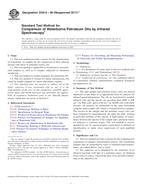We need your consent to use the individual data so that you can see information about your interests, among other things. Click "OK" to give your consent.
ASTM D3414-98(2011)e1
Standard Test Method for Comparison of Waterborne Petroleum Oils by Infrared Spectroscopy (Withdrawn 2018) (Includes all amendments And changes 11/7/2018).
Automatically translated name:
Standard Test Method for Comparison of Waterborne Petroleum Oils by Infrared SpectroscopySTANDARD published on 15.6.2011
The information about the standard:
Designation standards: ASTM D3414-98(2011)e1
Note: WITHDRAWN
Publication date standards: 15.6.2011
SKU: NS-23573
The number of pages: 10
Approximate weight : 30 g (0.07 lbs)
Country: American technical standard
Category: Technical standards ASTM
The category - similar standards:
Annotation of standard text ASTM D3414-98(2011)e1 :
Keywords:
petroleum, petroleum oils, waterborne, waterborne oils, infrared spectra, ICS Number Code 75.080 (Petroleum products in general)
Additional information
| Significance and Use | ||||||||||||||||
|
This test method provides a means for the comparison of waterborne oil samples with potential sources. The waterborne samples may be emulsified in water or obtained from beaches, boats, oil-soaked debris, and so forth. The unknown oil is identified by the similarity of its infrared spectrum with that of a potential source oil obtained from a known source, selected because of its possible relationship to the unknown oil. The analysis is capable of comparing most oils. Difficulties may be encountered if a spill occurs in an already polluted area, that is, the spilled-oil mixes with another oil. In certain cases, there may be interfering substances which require modification of the infrared test method or the use of other test methods (see Practice D3326, Method D.) It is desirable, whenever possible, to apply other independent analytical test methods to reinforce the findings of the infrared test method (see Practice D3415). |
||||||||||||||||
| 1. Scope | ||||||||||||||||
|
1.1 This test method provides a means for the identification of waterborne oil samples by the comparison of their infrared spectra with those of potential source oils. 1.2 This test method is applicable to weathered or unweathered samples, as well as to samples subjected to simulated weathering. 1.3 This test method is written primarily for petroleum oils. 1.4 This test method is written for linear transmission, but could be readily adapted for linear absorbance outputs. 1.5 This standard does not purport to address all of the safety concerns, if any, associated with its use. It is the responsibility of the user of this standard to establish appropriate safety and health practices and determine the applicability of regulatory limitations prior to use. Specific precautionary statements are given in Section 8. |
||||||||||||||||
| 2. Referenced Documents | ||||||||||||||||
|
Similar standards:
Historical
1.6.2013
Historical
1.6.2014
Historical
1.4.2012
Historical
1.4.2012
Historical
1.1.2011
Historical
1.10.2013
We recommend:
Technical standards updating
Do you want to make sure you use only the valid technical standards?
We can offer you a solution which will provide you a monthly overview concerning the updating of standards which you use.
Would you like to know more? Look at this page.



 ASTM D5482-07(2013)..
ASTM D5482-07(2013).. ASTM D5505-14
ASTM D5505-14 ASTM D5551-95(2012)..
ASTM D5551-95(2012).. ASTM D5553-95(2012)..
ASTM D5553-95(2012).. ASTM D5554-95(2011)..
ASTM D5554-95(2011).. ASTM D565-99(2013)..
ASTM D565-99(2013)..
 Cookies
Cookies
